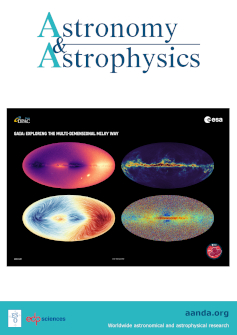从多波长脉冲剖面定位PSR J2229+6114的非热X射线发射
IF 5.4
2区 物理与天体物理
Q1 ASTRONOMY & ASTROPHYSICS
引用次数: 0
摘要
背景。脉冲星在整个电磁波谱范围内都能被探测到,从射电波长直到 GeV-TeV 范围内的极高能量。虽然年轻脉冲星的射电发射地点被精确地确定在光柱半径的百分之几高度,γ射线发射被认为是在光柱外的条纹风中产生的,但非热辐射 X 射线的产生地点仍然未知。这封信的目的是基于对PSR J2229+6114的多波长脉冲轮廓拟合来定位非热X射线发射区域,鉴于其较高的X射线亮度,PSR J2229+6114是一个特别好的候选者。根据联合射电和γ射线脉冲剖面推断出的几何形状,我们固定了磁轴倾角和视线倾角。但是,我们没有定位 X 射线发射区域,而是将其定位于表面和光柱之间的某处。我们通过拟合 NICER、NuSTAR 和 RXTE 望远镜分别在 2-7keV、3-10 keV 和 9.4-22.4 keV 范围内观测到的 X 射线脉冲轮廓,确定了这一区域及其延伸部分。我们确定非热 X 射线辐射来自 0.2 rL 和 0.55 rL 之间的高度,其中 rL 是光柱半径。磁偏角约为α ≈ 45° -50°,LoS倾角为ζ ≈ 32° -48°。这封信是第一批对脉冲星非热X射线发射位置提供严格约束的作品之一。我们计划将这一程序应用于其他几个有希望的候选者,以证实这一新结果。本文章由计算机程序翻译,如有差异,请以英文原文为准。
Localizing the non-thermal X-ray emission of PSR J2229+6114 from its multi-wavelength pulse profiles
Context. Pulsars are detected over the whole electromagnetic spectrum, from radio wavelengths up to very high energies, in the GeV-TeV range. While the radio emission site for young pulsars is well constrained to occur at altitudes about several percent of the light-cylinder radius and γ-ray emission is believed to be produced in the striped wind, outside the light cylinder, the non-thermal X-ray production site remains unknown.Aims. The aim of this Letter is to localize the non-thermal X-ray emission region based on a multi-wavelength pulse profile fitting for PSR J2229+6114, which stands as a particularly good candidate given its high X-ray brightness.Methods. Based on the geometry deduced from the joint radio and γ-ray pulse profiles, we fixed the magnetic axis inclination angle and the line-of-sight (LoS) inclination angle. However, we left the region of X-ray emission unlocalized, setting it somewhere between the surface and the light cylinder. We localized this region and its extension by fitting the X-ray pulse profile as observed by the NICER, NuSTAR, and RXTE telescopes in the ranges of 2–7 keV, 3–10 keV, and 9.4–22.4 keV, respectively.Results. We constrained the non-thermal X-ray emission to arise from altitudes between 0.2 rL and 0.55 rL where rL is the light-cylinder radius. The magnetic obliquity is approximately α ≈ 45° −50° and the LoS inclination angle is ζ ≈ 32° −48°.Conclusions. This Letter is among the first works to offer a tight constraint on the location of non-thermal X-ray emission from pulsars. We plan to apply this procedure to several other promising candidates to confirm this new result.
求助全文
通过发布文献求助,成功后即可免费获取论文全文。
去求助
来源期刊

Astronomy & Astrophysics
地学天文-天文与天体物理
CiteScore
10.20
自引率
27.70%
发文量
2105
审稿时长
1-2 weeks
期刊介绍:
Astronomy & Astrophysics is an international Journal that publishes papers on all aspects of astronomy and astrophysics (theoretical, observational, and instrumental) independently of the techniques used to obtain the results.
 求助内容:
求助内容: 应助结果提醒方式:
应助结果提醒方式:


